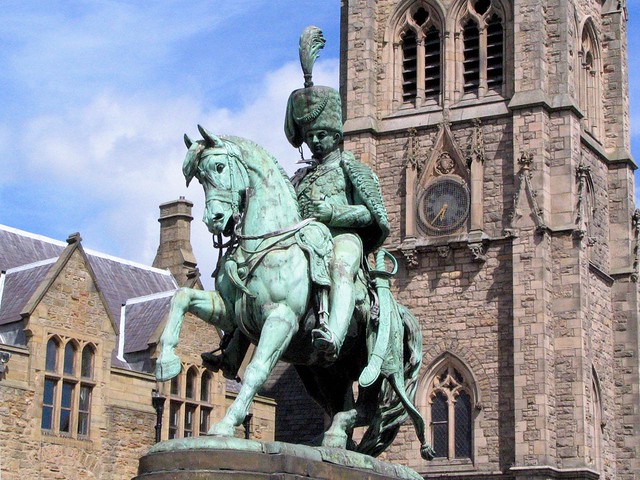Standing proudly in Durham’s historic Market Place, just a short walk from the city’s Cathedral and Castle, the statue of Charles William Vane, 3rd Marquess of Londonderry, is an imposing and often-photographed local landmark. Cast in bronze and elevated atop a stone pedestal, the equestrian statue has presided over the square since 1861, embodying both the grandeur and the controversy of a bygone era.
To many, it is a striking work of public art and a reminder of the city’s connections to power, wealth, and political influence in the 19th century. To others, it is a more complicated symbol, linked to imperialism, aristocracy, and the tensions of social class. Regardless of perspective, the statue remains a prominent part of Durham’s cityscape and a subject of enduring public interest.
Who Was the 3rd Marquess of Londonderry?
Charles William Vane (originally Charles William Stewart), the man immortalised by the statue, was born in 1778 and became the 3rd Marquess of Londonderry through his second marriage. He was a British Army officer, diplomat, politician, and industrialist—a multifaceted figure who played key roles in military and political life during and after the Napoleonic Wars.
He served with distinction under the Duke of Wellington in campaigns against Napoleon, rising to the rank of General. He was also the half-brother of Robert Stewart, Viscount Castlereagh, a central figure at the Congress of Vienna, which reshaped Europe after Napoleon’s defeat.
The Marquess was known for his support of industry, especially coal mining, and played a significant role in the expansion of the Durham coalfields. He owned several collieries in County Durham and built railways and infrastructure to support coal transport and trade—making him a key figure in the region’s industrial development.
The Statue: Art and Symbolism
The statue itself is an equestrian bronze, a format traditionally reserved for military and political leaders of great significance. It was sculpted by Raphael Monti, a notable Italian sculptor known for his neoclassical style, and unveiled to public ceremony in 1861, ten years after the Marquess’s death.
The Marquess is depicted in military uniform, mounted confidently on horseback, looking out over the bustling Market Place. The pose evokes themes of leadership, dominance, and control—both martial and economic. His sword, regalia, and the dignity of the composition are designed to elevate him as a figure of authority and influence.
The pedestal includes inscriptions and sculpted reliefs that reference his military career and his contributions to the coal industry. The statue’s prominent positioning near Durham Town Hall, facing the heart of the city, underscores the Marquess’s central role in shaping the region.
Legacy in Durham and Beyond
As a landowner and industrialist, Londonderry was both respected and feared. He invested in education and public works, but was also criticised for the harsh conditions endured by workers in his coal mines. His estates and businesses played a significant part in the industrial development of northeast England, but his paternalistic and aristocratic style of governance often clashed with the rising voice of the working class.
In local memory, he is remembered as a man who modernised infrastructure, including roads and railways, and contributed to economic growth. The town of Seaham, a port built for coal export, owes much of its existence to his vision. However, his reputation is mixed, as his wealth was accumulated on the backs of thousands of miners and industrial workers who faced hazardous working conditions.
This complex legacy is reflected in how people interact with the statue. Some admire it for its craftsmanship and historical importance; others critique it as a monument to a system that exploited labour and widened class divisions.
Public Attitudes and Modern Perspectives
In recent years, like many statues commemorating 18th- and 19th-century figures, the statue of the Marquess of Londonderry has come under renewed scrutiny. Conversations around public monuments—especially those linked to colonialism, the aristocracy, and labour exploitation—have led to a re-evaluation of such landmarks across the UK.
Durham has not seen major protests regarding the statue, but questions have been raised about the lack of interpretive signage to contextualize his role, particularly in relation to worker rights and political reform. Some have called for plaques or information boards that present a more balanced view of his contributions and controversies.
The statue still stands, as of 2025, without major alteration—reminding us that history is not static, but rather something we continually interpret, debate, and re-express in light of evolving values.
A Landmark for Locals and Visitors
For many residents, the statue is simply part of Durham’s familiar backdrop—a meeting point, a photographic attraction, or a feature of the Market Place that blends with the city’s medieval and Victorian architecture. Visitors often encounter it after climbing Silver Street from the riverside or exiting Durham’s many cafés and shops.
From its elevated perch, the statue offers an unexpected point of connection between the past and the present. Below it, life in Durham continues as it has for centuries: markets are held, street performers play, university students gather, and tourists pause to admire the square. Meanwhile, the bronze Marquess sits astride his steed, still gazing out over a city he helped shape.
Conclusion
The Marquess of Londonderry’s Statue in Durham is more than a decorative monument. It is a lens through which we can view nearly two centuries of economic, military, and social history. As a work of art, it stands tall among Britain’s better-preserved Victorian sculptures. As a piece of heritage, it forces us to reckon with the complexities of power, progress, and inequality in industrial Britain.
Whether admired for its craftsmanship, critiqued for its symbolism, or simply appreciated as a local fixture, the statue invites reflection. It encourages us to ask: Who do we choose to remember in stone and bronze? And how do those memories shape the stories we tell about our cities, our industries, and ourselves?
In the case of Durham, the Marquess remains—resolute and enduring, a permanent participant in the daily life of one of England’s most historic cities.

